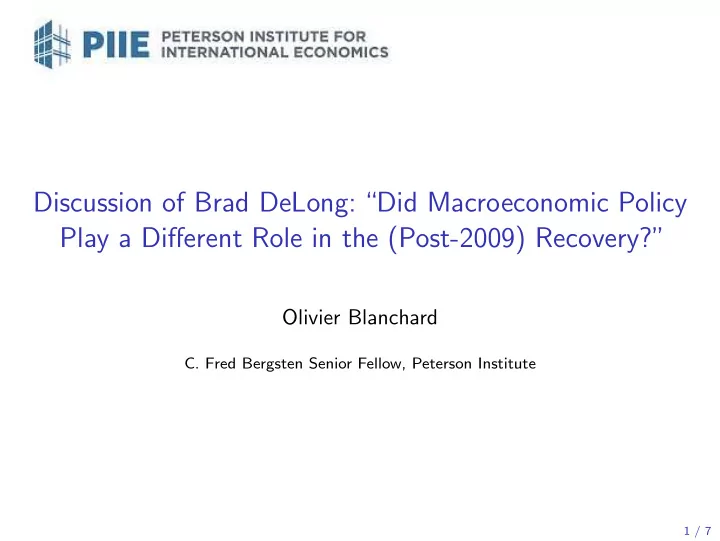

Discussion of Brad DeLong: “Did Macroeconomic Policy Play a Different Role in the (Post-2009) Recovery?” Olivier Blanchard C. Fred Bergsten Senior Fellow, Peterson Institute 1 / 7
Introduction ◮ I do not understand the title of the paper: “Did Macroeconomic Policy Play a Different Role in the (Post-2009) Recovery?” ◮ Different role from what? From its role in 2009? From its role before 2008? ◮ Gives me flexibility to interpret as I want � : ◮ Evolution in the thinking and the implementation of macroeconomic policy since 2008. ◮ Four phases: Pre-2008, 2008-2009, 2010-2015, now, and the future (both forecast and normative) 2 / 7
Pre-2008. The preeminence of monetary policy ◮ Monetary policy: ◮ Inflation targeting. Taylor rule. ◮ Unlikely to be used, but available: LOL. Thought as fully separate from first. ◮ No use of fiscal policy, except automatic stabilizers ◮ Micro pru and financial regulation, no macro pru. ◮ Crisis first perceived (from 2007) as a housing crisis. Lower policy rate ◮ Coinciding initially with high oil prices. Higher policy rate (increase in October 2008) 3 / 7
From 2008 to 2009; All hands on deck ◮ Rediscovery of what a financial crisis is. The importance of plumbing. ◮ Monetary policy: ◮ Interest rate down to zero ◮ Provision of liquidity much beyond traditional LOL. QE 1: (nov 2008 to june 2010. ) ◮ Macro prudential. Stress tests. Raising capital ratios. Denominator/numera ◮ Fiscal expansion. ◮ Partly automatic stabilizers/partly more. ◮ Increase in structural deficit for AEs by +2% from 2008 to 2009 (Actual +5.3%) 4 / 7
From 2009 to 2015. More monetary, less fiscal ◮ Cold feet on fiscal. ◮ Why? Fast increasing debt level. The 60% number. (Reinhart Rogoff, Maastricht). In AEs, increase from 48% in 2008 to 70% in 2012. ◮ Decrease in structural def from 6.4% in 2010 to 2.5% in 2015, with rough stabilization of debt around 70% ◮ By default, further exploration of non conventional money. Through de- crease in spreads. ◮ QE now seen as monetary policy than LOL liquidity provision. ◮ Frozen inflation expectations. Actions needed, not just words. ◮ Much talk, but limited action on macro pru: Some LTVs; more at the BOE. ◮ Financial regulation: Dodd-Frank, Basel II, Basel III. 5 / 7
Since 2015. Second thoughts ◮ A new environment. Secular stagnation may be for real ◮ Lower potential growth ◮ Low neutral rates ◮ Second thoughts on unconventional monetary policy ◮ Reaching perceived limits. Risks, distortions, distributional effects ◮ Low for very long may be dangerous: Insurance companies, pension funds ◮ By default: A second look at fiscal. ◮ In 2016, (small) increase in AE structural deficit. ◮ Optimal debt policy if MPK > g > r . Public investment? ◮ Financial regulation? Has it gone too far? Business model of banks? 6 / 7
Looking forward ◮ Perception of a new tougher normal. Low growth, low neutral rate ◮ Monetary policy probably changed forever. ◮ Should CB affect level and spreads? Rate and risk/liquidity spreads. Size of balance sheet. ◮ Higher inflation target versus less cash. ◮ Start of a discussion about scope for policy in next recession ◮ Fiscal. Little action, but serious discussion starting. ◮ My own sense (hope?). More use of DSAs. Dynamic scoring. ◮ Golden rule? ◮ Fuzzy limits fiscal/money? Helicopter money. Probably not healthy. ◮ Macro prudential versus regulation. How much of one, and how much of the other? 7 / 7
Recommend
More recommend